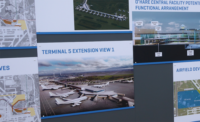The one project that did move forward under the PPI program—the Northwest Corridor plan to add managed HOV and truck lanes to I-75 and I-575 near Marietta—was scuttled as the Georgia General Assembly revisited P3s.
A revised approach, enacted in 2009, authorizes GDOT to identify and solicit proposals better suited to its long-term strategy. It has short-listed three consortiums for a project that combines the original Northwest Corridor plan with managed lanes on a stretch of Interstates 20 and 285 into a broader effort called West by Northwest. GDOT plans to issue an RFP in September, with a goal of financial close by July 2011.
The program does permit unsolicited proposals, but Spear says the State Transportation Board likely will not accept them, at least for now.
Moving Forward
Texas, which suffered setbacks in previous P3 pursuits, is trying again in a big way, with two road projects in the Dallas-Forth Worth area: the $2.7-billion LBJ-635 Express and the $2.5-billion North Tarrant Express (NTE).
Both the LBJ, which just achieved financial close, and the NTE, which did so last year, have the Dallas police and firefighter pension system as an equity partner. As with Florida, as legal adviser to the Texas Dept. of Transportation, Nossaman helped restructure the deals. “The credit markets froze around October 2008,” recalls Christine Ryan, Nossaman partner. “The proposals for the North Tarrant Expressway were due in December. A month later, the I-635 proposals came in.”
In September, TxDOT signed a comprehensive development agreement (CDA) with the LBJ Infrastructure Group (LBJIG), led by Spain’s Cintra. On June 17, the $4-billion deal reached financial close. The goal had been to do both concurrently, says Nossaman’s Kessler. “But we had to give proposers time to wait out the meltdown.”
Cintra’s partners include New York City-based Meridiam Infrastructure North America, Houston-based W.W. Webber and the Spanish firm Ferrovial Agroman. The deal allows TxDOT to leverage its investment about five times “without waiting for limited taxpayer resources to become available,” says Joe Aiello, CEO of Meridiam.
Construction will start in 2011 on the LBJ-635 and last five years. It will add up to 13 miles of six toll lanes within the existing footprint.Three lanes will dip 25 ft below grade in some areas. LBJIG spokesman Andy Rittler says after 52 years, the team will hand the road back and “will basically be able to write the project off, assuming consumer price indexes and material costs don’t fluctuate beyond the norm.”
In 2009, TxDOT awarded two CDAs for the NTE to NTE Mobility Partners—also consisting of Cintra, Meridiam, Ferrovial, Webber and other firms—to build two managed lanes in each direction, plus two general-purpose lanes along 13 miles from north of Fort Worth to southwest of the airport. The concession is for 52 years. The team will develop master plans for a total of 36 miles of managed lanes.
In Denver, the Rapid Transportation District (RTD) chose a team called Denver Transit Partners (DTP), led by Macquarie and Fluor, for its $2.1-billion P3 proposal to build some 40 miles of commuter rail. The Eagle proposal includes opening the central line between Denver and its airport by 2016, 11 months early.
Like many P3s lately, RTD will pay the non-winning proposer a $2.5-million stipend in exchange for intellectual property, giving RTD the option to use cost-saving ideas. DTP over 40 years will receive annual payments from RTD based on its meeting RTD’s service standards.
DTP includes partners Ames Construction, Balfour Beatty Rail Inc., Alternate Concepts Inc. and HDR. Jim Moynihan, CEO of Balfour Beatty Rail Inc., says transit poses unique challenges, including both rolling stock and fixed facilities. “The challenge for this project is going to be the systems integration,” he says.
Ongoing Debate
More P3 lessons will be learned as debates continue and critics speak out. Ken Orski, P3 expert and editor of Innovation Newsbriefs, says lawmakers are still wrestling over the ultimate role of the federal government. “As a financial partner in P3s ... the federal government shares the responsibility for protecting the public interest,” he adds. But overly regulated federal oversight of P3s would cause private investors to balk.
He also questions the availability payments at the heart of the I-595 and the Port of Miami projects, calling them “a way of financing public projects on an installment plan with public funds.”
Officials contend that I-595 and POMT involve $280 million of equity and about $2.2 billion of debt that is contingent upon successful completion of the contracts, and they note the risk-averse state of financial markets in 2008-2009. “We look carefully, critically and with an open mind at all processes that allow us to leverage limited funds to help us realize projects sooner,” says FDOT’s O’Reilly.
Michael Likowsky, a research fellow at New York University, warns of “the habit of shouldering too much of the risk of P3 investors. For instance, the people of Texas are providing heavily subsidized bonds in order to make the North Tarrant Expressway attractive to investors.”
Parker acknowledges that, in general, “We are seeing in some transactions a tendency to lighten up on risk transfer.” He says, “It’s key for owners to hold the line a bit. If you end up giving too many subsidies, you do have to reconsider doing projects as design-build-operate-maintain, et cetera.” Adds Patrick Harder, a Nossaman partner, “It’s about the art of the deal—knowing when to push and when to give in.”










